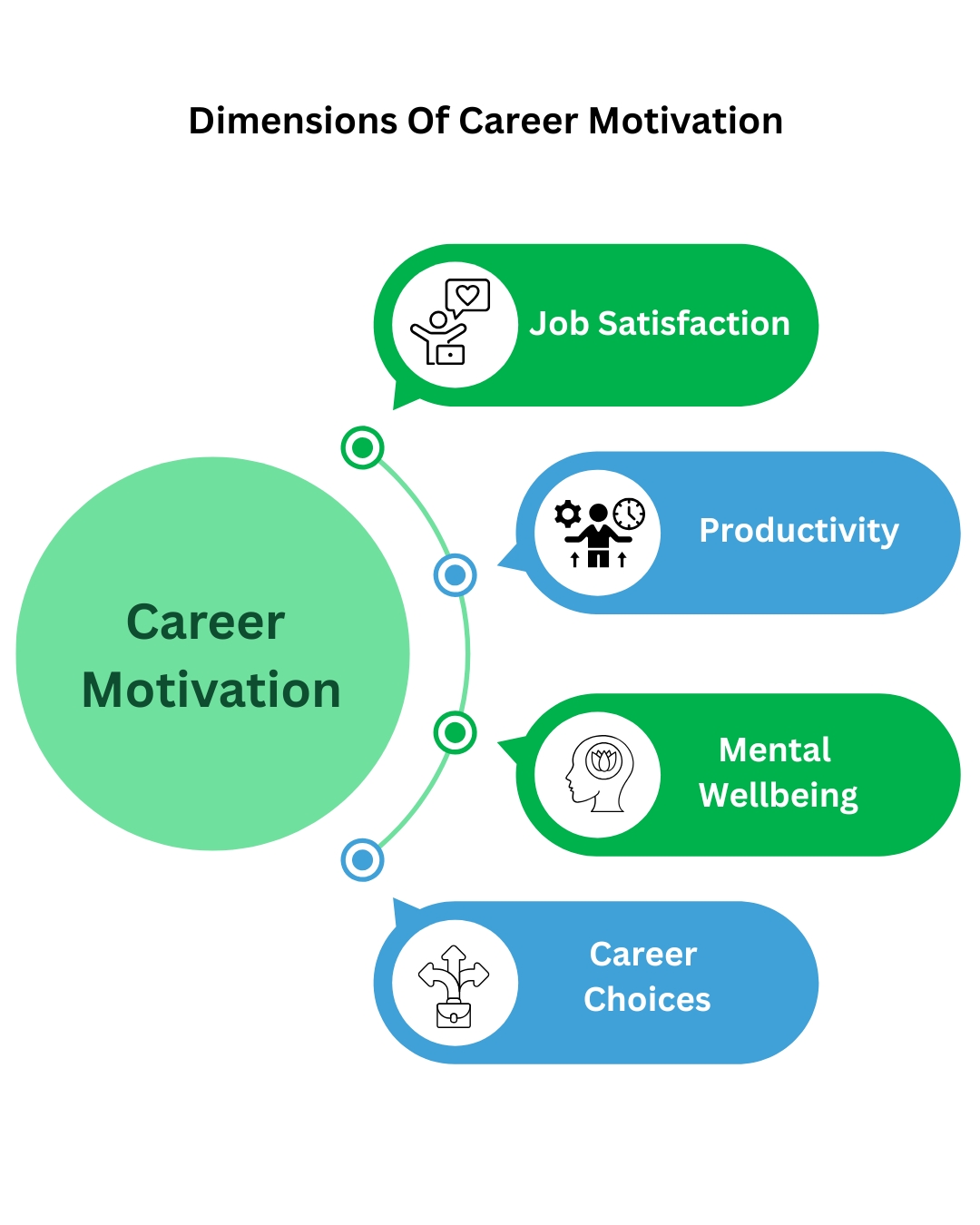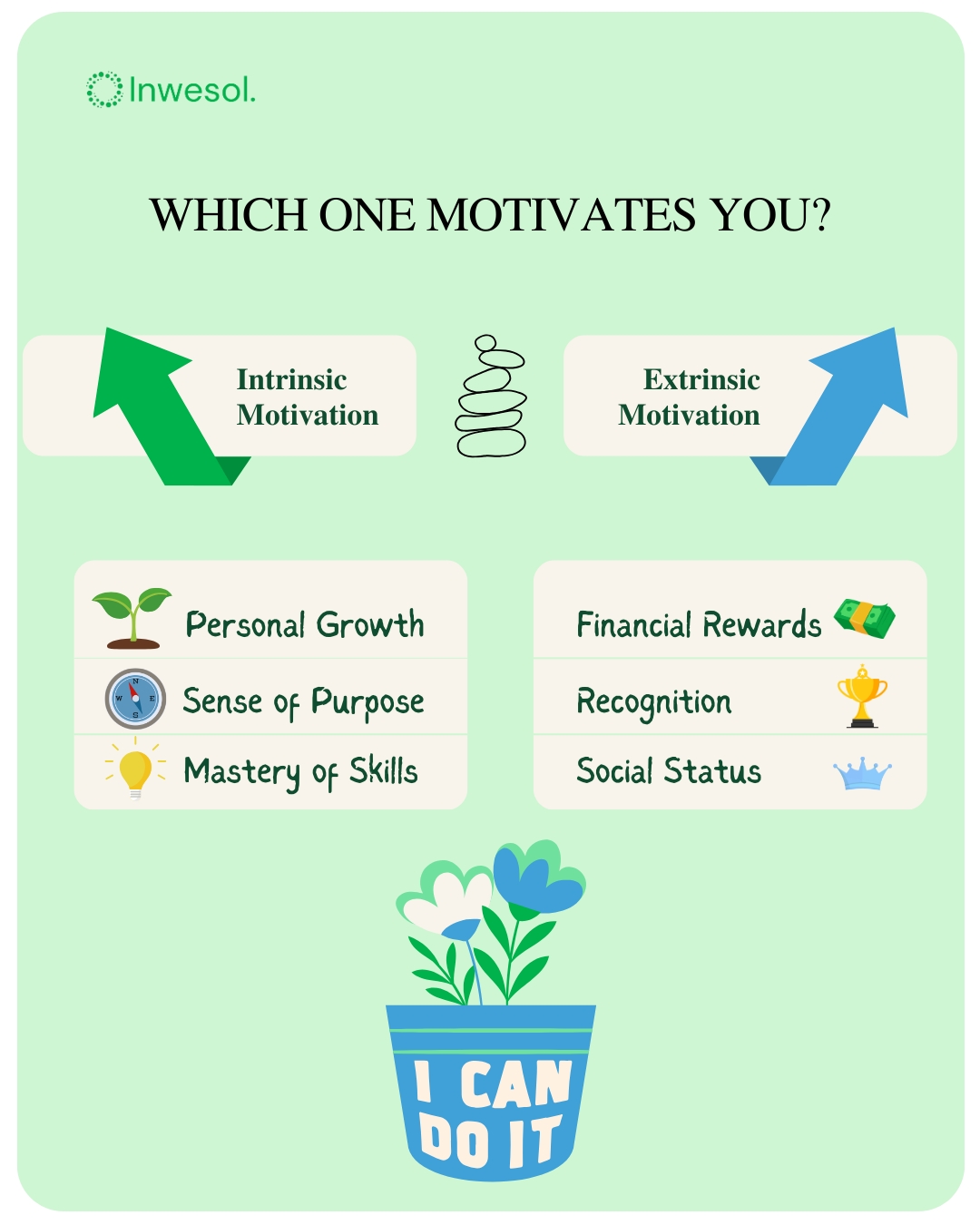
July 15th, 2025 • 5 min read
Career Motivation refers to the drive that influences a person’s behaviour within the professional work environment. Think of career motivation like the GPS in a car. You might have the car (your skills), the road (opportunities) and the engine (your effort), but without the GPS, it’s easy to get lost. Your motivation sets the direction, keeps you focused when the road gets tough. Career motivation is what propels us toward specific occupations, strives for us to work diligently and seeks significance in our careers. This motivation is never purely about needing a salary check, it's rooted in our psychology and influences how we perceive ourselves and our position in the world.

When you become seriously motivated in your career, you have higher job satisfaction, in the sense that you will enjoy the work rather than dreading Sunday nights and Monday mornings. This motivation translates into better productivity, as motivated individuals work harder at their projects and be more creative at solving problems (Westbrook et al., 2020). Most significantly, career motivation has a tremendous impact on our overall health and mental well-being.
When we are career motivated, our brains release chemicals like dopamine and serotonin that make us feel good and energize us. This is a healthy feedback loop in which achievement creates more motivation that then creates even more achievement (Bromberg-Martin et al., 2010; Fischer & Ullsperger, 2017). On the other hand, when we are not career motivated, we experience symptoms of depression like fatigue, cynicism and despair about the future (Bianchi et al., 2023).
Studies again and again identify that motivated workers are not only happier but also more creative, collaborative and better able to bounce back from failures. They're apt to do more than expected of them, accept learning experiences, and be a positive influence in their work environment. For adolescents anticipating their future, it's essential to study career motivation because it can help you make better choices regarding education, internships and future career choice. For parents, it can help you direct how you talk with your child regarding career choice, not only about what they will earn, but what will bring them happiness in the long term. Now let’s understand the types of motivation.

Self-Determination Theory, which was developed by psychologists Edward Deci and Richard Ryan, teaches us about two main types of motivation.
- Intrinsic motivation is from the inside out. It's the enjoyment you get from doing something because it's something you really enjoy doing, find interesting, or feel it's worth doing. An example would be a teenager who likes writing computer programs for video games. He or she is intrinsically motivated by computer programming.
- Extrinsic motivation is from external rewards or pressures, such as working for a lot of money, approval, or to escape punishment.
In Self-Determination Theory, three basic psychological needs motivate us:
- Autonomy (being in charge of our choices)
- Competence (feeling effective and able)
- Relatedness (being connected to others)
When these needs are met in our work environment, we are more intrinsically motivated. For instance, a job where you get to choose how you will work (autonomy), stretches you just enough so you can build your skills (competence), and has healthy relationships with others (relatedness) will simply be more motivating.
Extrinsic rewards are vital and can serve as a motivator, but they work best as a complement to intrinsic satisfaction and not as the only source. With this knowledge, you can look beyond surface level career characteristics and study how different paths can meet your inner psychological needs.
The Contribution of Intrinsic Motivation to Sustained Career Satisfaction
Intrinsic motivation is a sustainable fuel source for your career; it will not burn out like external rewards tend to. When you're intrinsically motivated, you're motivated by internal values, interest and the intrinsic satisfaction of the work itself. This is a highly stable basis for long term career excellence and satisfaction because you're not waiting around for someone else to get you pumped up with praise, promotions or raises.
A teenager who has an interest in the preservation of the environment may be deeply satisfied with a career in researching renewable energy, irrespective of pay prospects, because the profession is associated with their fundamental values. A person with innate talent for teaching and an interest in helping others is likely to be satisfied with teaching careers because the profession itself is satisfying.
The autonomy and competence aspects of Self Determination Theory come into play most here. When you have some control over how you do your work and feel confident in your ability to grow and learn, you are more likely to stay motivated even when things get challenging. Your intrinsic motivation grows strong too when you fail or encounter setbacks, your intrinsic motivation propels you forward instead of making you quit.
Intrinsic motivation becomes self reinforcing as well. If you enjoy what you are doing, you work harder at it naturally, which leads to better performance and greater competence. This competence creates new challenges and opportunities, which further engage your interest and participation. For parents and teenagers planning ahead, this translates to considering not only "What pays the most?" but "What would I truly be interested in and like to do for many years?" The goal is finding careers that energize rather than drain you in the long term.
Balancing Extrinsic Rewards with Personal Purpose
Though intrinsic motivation is most important for long term happiness, eliminating extrinsic rewards altogether is unrealistic. We all need to pay bills, put food on the table and achieve financial security. The trick is finding the right balance and understanding how outside rewards can motivate or destroy our inner motivation. Research shows that when extrinsic rewards like money are the priority, they can actually suppress intrinsic motivation, a process known as the "overjustification effect” (Deci, 1971).
For example, if one picks an occupation solely for money without considering their values or interests, they might be initially motivated by the money. However, after some time, this motivation will wear off, leading to burnout, job dissatisfaction and a sense of emptiness. The money that was the central importance might not be sufficient to counteract the feeling of getting eight hours a day doing something that is nonsensical or against their values.
The best approach to sustainability is to use extrinsic rewards as secondary elements rather than the central foundation of career motivation. Look for careers with equitable pay and career opportunity as well as for value and interest alignment. For example, someone with an interest in helping other individuals might choose healthcare, social work, or nonprofit management careers that offer both meaningful work and equitable career prospects.

Think about creating a personal "motivation portfolio" with both intrinsic and extrinsic elements. Maybe 70% of job satisfaction comes from doing valuable work that you enjoy and 30% from extrinsic rewards like pay, benefits and perks. This proportion will also vary for different individuals and at different stages of life, but having knowledge of both kinds of motivation enables you to make wiser career decisions.
When parents and adolescents discuss career options, they should be asking questions like: "How can we seek out employment that is satisfying and well rewarding?". This two way answer ensures rewards from external sources are supplemented rather than replaced by intrinsic motivations and careers are realistically attainable and genuinely fulfilling.
Harnessing the power of both intrinsic and extrinsic motivation can transform not just your career, your confidence. Are you driven by inner passion or external rewards? Maybe it’s both? It’s time to reflect, realign and rise. Tap into what fuels you from within, curiosity, growth or purpose and let external recognition or advancement be the wind in your sails. Take action now: set a goal that speaks to your values and back it with steps that move you toward personal and professional fulfillment. Your motivation, in all its forms, is your most valuable asset. Use it.
So, what’s your next move? Whether it’s gaining clarity, building confidence, or aligning with your purpose, START NOW
Explore our free career resources, book a discovery session with our coaches, or attend an Inwesol workshop near you.
Not sure where you stand? Check your career readiness in minutes
Ready to take the first step? Book a free session with career coach
References:
• Westbrook, A., van den Bosch, R., Määttä, J. I., Hofmans, L., Papadopetraki, D., Cools, R., & Frank, M. J. (2020). Dopamine promotes cognitive effort by biasing the benefits versus costs of cognitive work. Science, 367(6484), 1362–1366. https://doi.org/10.1126/science.aaz5891
• Bromberg-Martin, E. S., Matsumoto, M., & Hikosaka, O. (2010). Dopamine in motivational control: Rewarding, aversive, and alerting. Neuron, 68(5), 815–834. https://doi.org/10.1016/j.neuron.2010.11.022
• Fischer, A. G., & Ullsperger, M. (2017). An update on the role of serotonin and its interplay with dopamine for reward. Frontiers in Human Neuroscience, 11, 484. https://doi.org/10.3389/fnhum.2017.00484
• Bianchi, R., Verkuilen, J., Sowden, R. N., & Schonfeld, I. S. (2023). Towards a new approach to job-related distress: A three-sample study of the Occupational Depression Inventory. Stress and Health, 39(1), 134–150. https://doi.org/10.1002/smi.3177
• Deci, E. L. (1971). Effects of externally mediated rewards on intrinsic motivation. Journal of Personality and Social Psychology, 18(1), 105–115. https://doi.org/10.1037/h0030644